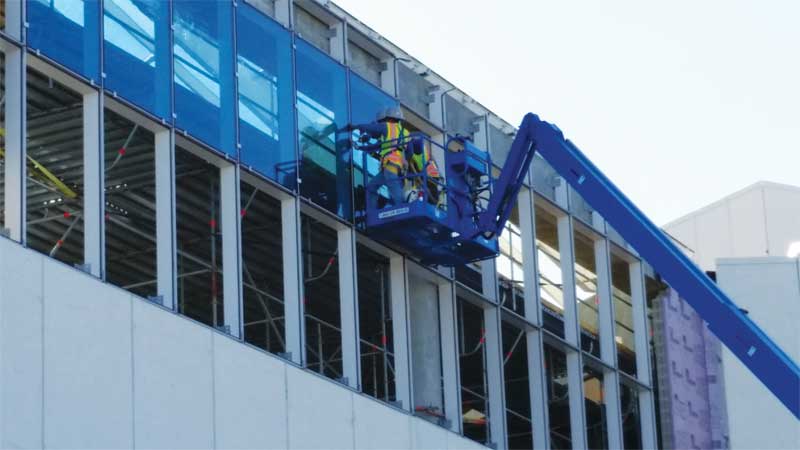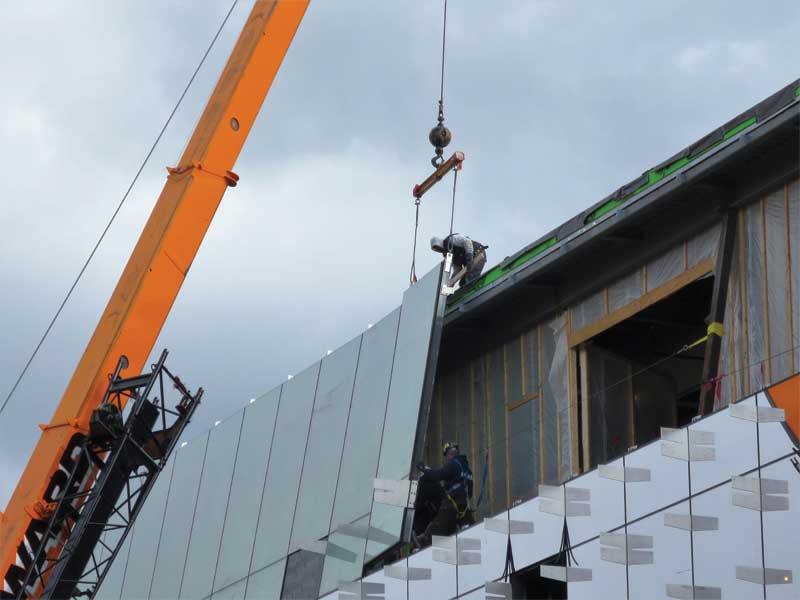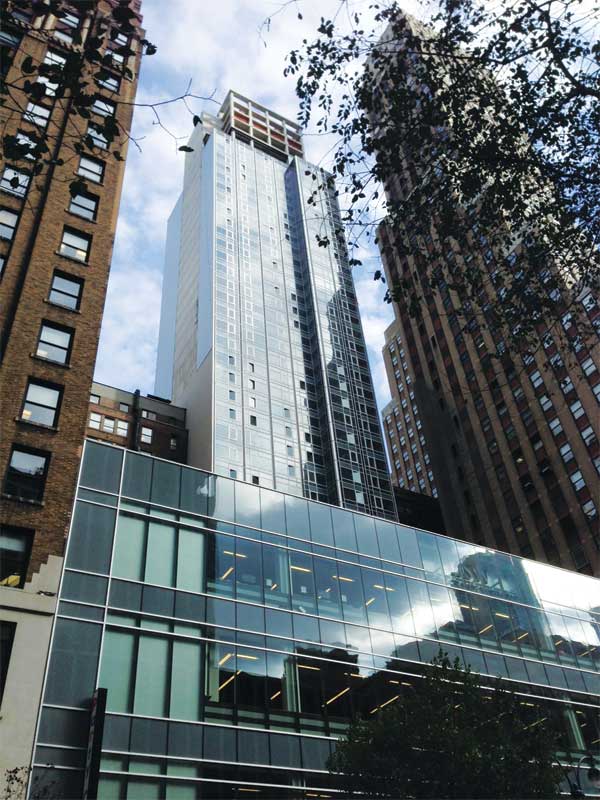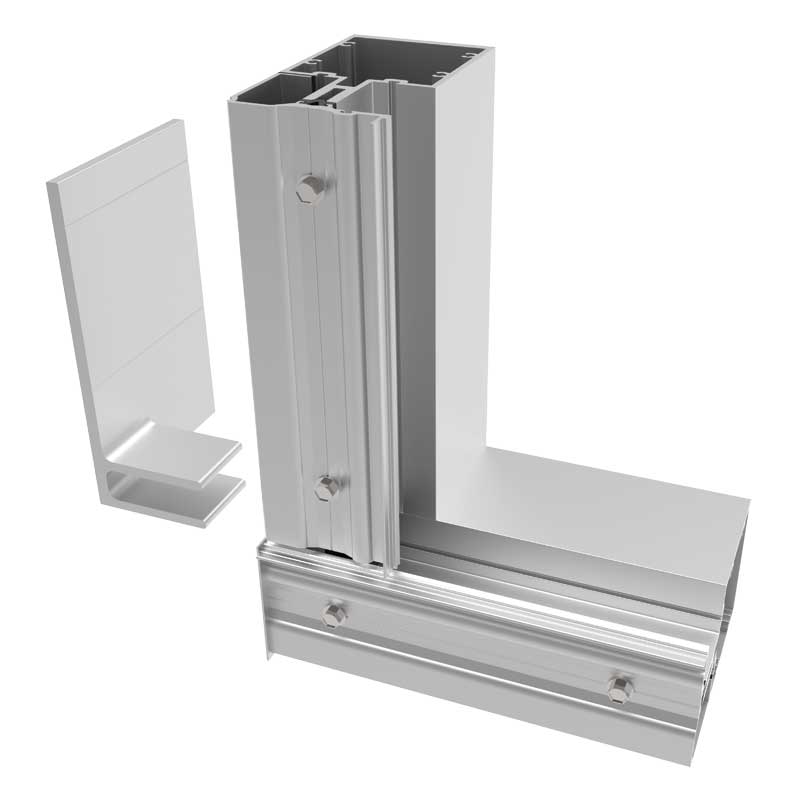A growing unitized movement
by Katie Daniel | February 6, 2018 10:20 am
 [1]
[1]by Greg Galloway
In today’s construction climate, increasingly tight schedules and rapid building close-ins are highly critical to success. Many factors can contribute to a successful project, but the type of system and method of installation used on the building façade—stick-built versus unitized systems—can have a large impact on a structure’s overall timeline. Unitized construction is not a new development, but is a growing one given the importance of quality, time, and ongoing labor challenges today. So what are the differences between stick-built and unitized façade systems? What are the benefits of unitization, and also what do architects and Glazing contractors need to know before specifying unitized systems?
First, it is important to understand the basic difference between stick-built and unitized façade systems. Stick-built assemblies require an aluminum fenestration system to be delivered to the jobsite. The installer then assembles and installs the individual components on the structure, piece by piece (Figure 1). It can provide upfront cost savings over a unitized system as well as offer shorter product lead times. However, stick-built systems require more onsite labor, which often results in more time spent on the installation process. Environmental considerations like weather delays can also impact the timeline. This can also be a factor in the quality control process, as some more extreme conditions such as high humidity, dirt, and temperature swings can impact the sealing process.
Unitized systems, on the other hand, are fabricated, assembled, and glazed in a factory environment, then shipped to the jobsite for installation. The large glass units are then hoisted onto anchors which are connected to the building.
 [2]
[2]Beyond the curtain wall
Over the past few years, some architects and contractors have begun to shift toward unitized systems to solve many of the ongoing hurdles facing the construction industry. Tight construction schedules, crowded jobsites, and a shortage of both skilled workers and installers continue to plague the industry. Unitization can help address these issues while providing a high level of quality assurance and reducing overall project costs and time to close the building.
Traditionally, unitized systems have been used in curtain wall applications and predominantly in high-rise projects like condominiums. However, there
has been a more recent movement toward unitized or pre-glazing for low- to mid-rise projects. This has expanded the unitized market to products like window walls (Figure 2) and storefronts, bringing the benefits of unitization to a wider range of projects regardless of size or complexity.
Benefits of unitization
Unitized façade systems’ rising popularity is partly due to their various benefits.
 [3]
[3]Reduced costs
Unitization lessens the use of more expensive field labor, often reducing overall project costs. As previously mentioned, labor shortage continues to plague the construction industry. The lack of skilled workers has raised the cost of field labor. Given unitization provides for shop fabrication, glazing, and assembly, it can reduce the amount of labor needed at the jobsite. This then allows the glazing contractor to get more done, working faster to meet demanding deadlines. As a result, other subcontractors on the project are better able to start subsequent work either on time or, in some cases, ahead of schedule. This can lead to huge overall cost savings for the project. General contractors increasingly recognize these benefits and set schedules that restrict the amount of ‘time onsite’ for glazing contractors. This forces a unitized or pre-glazed solution.
Improved quality control
Unitization improves quality control because of preassembly in a shop where it is protected from environmental elements. In a more traditional, stick-built approach, units are assembled in the field, where environmental conditions and disruptors at the jobsite may impact the end product. Unitization takes this out of the equation and brings the entire fabrication and assembly process into a controlled environment. The manufacturer’s or glazing contractor’s shop is an ideal setting for critical seals, where environmental factors such as dirt and rain are not a problem. Dry-in time can be significantly faster than onsite glazing, expediting the time it takes to close the building. Additionally, staff is more closely supervised in a shop environment—from monitoring attendance to supervising work assignments—which provides improved quality assurance in the fabrication of all components.
Suitability for dense areas
Unitization can bring strong benefits to projects in large cities where there may not be enough space or time. Hence, the unitized movement has been most apparent in densely populated urban markets, where labor is expensive and installation is difficult from a logistics standpoint. As unitized systems come to the jobsite ready to be installed, they save a significant amount of space in these urban environments where there is a limited ability to store materials, stage, and glaze large units onsite.
 [4]
[4]The challenges of unitization
It is important to gain a full understanding of unitization’s inherent challenges before specifying this type of façade system.
More stringent planning requirements
Unitized systems require more careful planning. As discussed, one of the core benefits to unitized systems is the ability to have panels fabricated, assembled, glazed, and ready to install at the jobsite. However, because the majority of work is done at the shop, it is critical project managers carefully plan ahead, allowing adequate lead time for unitized systems.
Lower adaptability
Given unitized systems come ready to install, they are less forgiving on the jobsite. In a stick-built environment, contractors can fix many issues that arise the next time a stick is cut and continue to adjust along the way. Yet, unitized systems must work together seamlessly and lock tightly on the jobsite. This makes the upfront planning and measuring process very critical to the success of a unitized project. Additionally, unitized anchors must offer a greater range of adjustment on all three axes.
More stringent contractor requirements
Unitization requires the right glazing contractor for the job, one with adequate space as well as special fabrication and handling equipment. It is critical to line up the right glazing contractor, who must be equipped with the proper shop space and the ability to lift and transport heavy units. Since fabrication of the panels happens at the shop, a large staging area is critical to the project’s success. This requires a large, organized space to receive all of the project materials (including aluminum, glass, and panels) and set up a highly organized assembly line to properly fabricate them. The assembly line process maximizes production and increases productivity.
Altered labor dynamics
From the field to the shop, unitization shifts the labor force. Although unitization saves on field labor, it also changes the dynamics of the type of labor needed for a project. A glazing contractor executing a unitized project must also have a larger, more specialized workforce with the proper training and expertise in the area of operation. Shops that pre-glaze or unitize tend to be larger than average. Unitization in a very small shop creates a ‘feast or famine’ condition. This is easier to smooth out as the scale of the business gets larger.
Specialized roles typically needed in a unitized shop environment include project management, computer numerical control (CNC) operators, field installation labor, and specialized engineering.
 [5]
[5]Project management
A project management team must set up the assembly line and manage fabrication, quality control, proper labeling, shipment, and installation schedule to ensure a project’s success in unitized shops’ highly controlled and organized assembly line environment.
CNC operators
Programming and operating CNC machinery, which is needed in a unitized shop environment, requires a higher level of expertise, and employees must be trained accordingly.
Field installation labor
Unlike stick-built, unitized projects have a reduced field crew size—typically composed of a lead field project manager or superintendent and a small installation crew.
Specialized engineering
The ability to identify critical details during the engineering stage is important in a unitized system, as many projects rely on tools such as building information modeling (BIM) to clearly see the interface of the fenestration as well as other building envelope components.
Coordination among trades and suppliers is also critical to ensure no adjustments need to be made in the field. For example, the location and sizing of the anchors is essential.
 [6]
[6]Unitization in action
The recently completed historic Troubadour Hotel in New Orleans provides an example of a unitized project. The 184-room luxury boutique hotel sits in the Central Business District in the heart of New Orleans. Formerly a 17-story office building, it was the site of a deadly fire in 1972. A quite extensive renovation was required to restore the hotel, and it was initially envisioned as a stick-built project.
The design team soon discovered the concrete was heavily laden with rebar, which was common to the era, and would have slowed installation. Glazing contractor DeGeorge Glass led the team to an innovative, pre-glazed solution. The curtain wall was installed into the new metal stud walls via modified F anchors (Figure 3), which slide into the curtain wall as usual, but have a wider leg to allow it to function more like a strap anchor. This enabled pre-glazing and facilitated extremely fast installation, which reduced congestion on the jobsite.
Conclusion
Given the current state and predicted future of the construction industry, unitization is here to stay and will continue to evolve into new and different project applications. There are many factors to consider before specifying a project as unitized. Having an awareness of the core considerations means when looking at the building envelope, one can determine whether to specify stick-built or unitized.
Greg Galloway is a brand manager for YKK AP America. He started his career in manufacturing and was an ASQ Certified Quality Engineer before transitioning into marketing. Galloway has more than 30 years of experience in residential and commercial fenestration with accomplishments in strategic business planning, market intelligence, and brand and product management. He has been active in the design, building, and marketing of hurricane impact and blast mitigation products. Galloway also currently serves on the Southeast American Architectural Manufacturers Association’s (AAMA’s) technical committee and board of directors. He can be reached via e-mail at greggalloway@ykkap.com[7].
- [Image]: https://www.constructionspecifier.com/wp-content/uploads/2018/02/Hotel.jpg
- [Image]: https://www.constructionspecifier.com/wp-content/uploads/2018/02/Figure-1b-unitization.jpg
- [Image]: https://www.constructionspecifier.com/wp-content/uploads/2018/02/Figure-2-unitization-e1517513855827.jpg
- [Image]: https://www.constructionspecifier.com/wp-content/uploads/2018/02/Cornell.jpg
- [Image]: https://www.constructionspecifier.com/wp-content/uploads/2018/02/NewYork.jpg
- [Image]: https://www.constructionspecifier.com/wp-content/uploads/2018/02/Anchor.jpg
- greggalloway@ykkap.com: mailto:greggalloway@ykkap.com
Source URL: https://www.constructionspecifier.com/growing-unitized-movement/